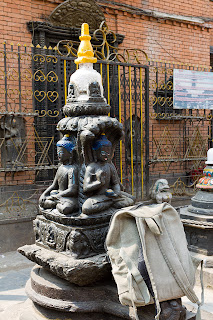 |
| Playful lion cubs, Lobo area of Serengeti National Park |
In December 2012,
our friend Owen Floody went to northern Tanzania, traveling with his wife,
several friends, and a guide. They stayed
in tent camps and lodges and visited Tarangire National Park, Lake Manyara National
Park, the Seronera and Lobo regions of Serengeti National Park,
Ngorongoro Crater and the Ndutu region of the Ngorongoro Conservation Area,
going out each day to view the scenery and wildlife. Owen’s photographs of the trip are superb—he is
more than lucky—he is a talented photographer.
In 1971, when Owen and my husband Art were graduate students studying
animal behavior, they were partners in a field research project studying Uganda
kob (a kind of antelope) in Queen Elizabeth National Park in Uganda. (See my post for May 16, 2011.) Owen has been back to Africa several times
since then. Here is a short reflection on his most recent trip and a few of his
amazing photographs.
 |
| Elephant calves playing in the mud, Tarangire National Park |
Owen's post: In my opinion, a
worthy goal on wildlife-oriented trips is to be grateful for what you're given,
the latter being something that will never be completely under your
control.
But it is nice to have the luck
required to eliminate any suspense regarding your success.
On our most recent trip to northern Tanzania,
in East Africa, we were so lucky that even our bad luck turned good.
 |
| Stormy skies over the African savannah, Lobo area of Serengeti NP |
I had timed this
trip to avoid the rains, but this was not to be: We had some rain on most days,
sometimes turning park tracks into what looked more like canals.
Fortunately, this did not faze our vehicle or
guide, who somehow managed to keep us moving through everything but the
aardvark burrow.
And in return for those
rains we got two unexpected benefits.
One was the wonderful stormy skies that help to set off some of my
favorite landscape photos. The other was the absence of potentially choking
dust.
Initially, we greeted a short
stretch of dry days with pleasure.
Quickly, however, we noticed the tracks becoming dustier and dustier,
and found ourselves wishing for a return of the rains.
In moderation, of course.
 |
| Yawning hippo, Ndutu area of Serengeti National Park |
Our luck also was
good in all of the more obvious ways.
We
saw great sights, including leopards lounging in trees, elephant calves and
lion cubs at play (not with each other, unfortunately), lions and vultures
cleaning up a kill, and hippos defending their spaces.
In some cases, we even were the first to come
upon these sights, and so had them completely to ourselves for part or all of
the time.
 |
| Cantankerous vultures, Ndutu area of Serengeti National Park |
Though I speak of
luck, I know that part of this is skill--mainly on the part of our guide--and
another part attitude.
The broader your
interests, the "luckier" you will be.
We were happy to see members of the "big five" (lions, leopards, elephant, buffalo and rhino--deemed to the top of the list for most tourists) but were as
delighted to see attractive birds and vegetation.
 |
| Lounging leopard, Seronera area of Serengeti National Park |
Fortunately for us and others like us, there
are lots of great birds out there, and you're likely to see many of them if you
make the effort.
And the vegetation is
least likely of all to get away from you (and surest to benefit from any rain).
Sometimes you'll even find small creatures
hiding in or near it.
I encourage you
to take advantage of these opportunities and plan your own safari. Be sure to make at least some of your own
luck.
 |
| Baobab tree with giraffe in distance, Tarangire National Park |
Owen's trip began and ended in the town of Arusha, in northern Tanzania. The group stayed in three places during the two week trip: Lobo Wildlife Lodge in Serengeti National Park; Ndutu Safari Lodge in the southwestern Serengeti area near Olduvai Gorge; and Ngorongoro Farm House in the Ngorongoro Conservation Area.

























